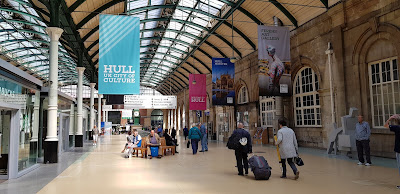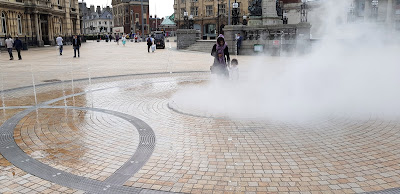Hull, that big sprawling city in flat East Yorkshire on the north side of the River Humber, has an image problem. It has no charisma. It sounds so unromantic. You picture it as bombed to death in the Second World War, and imagine all the post-war utilitarian rebuilding in concrete looking drab and dispiriting - grimy, crumbling, graffiti-covered, and fit for demolition. You suspect that there is a faint smell of fish in the air from decaying docks. And isn't Hull one of those cities with the shortest average life expectancy in the UK, because the low-achieving inhabitants smoke and drink too much, eat badly, and are all chronically obese?
In this post I want to show that this is a false picture. Hull is a very nice place indeed, completely underrated. Of course its suburbs are dull. Which city's are not? But the centre is a quite different matter. And it isn't all down to a very recent makeover, the result of Hull's winning the bid in 2013 to be the 'UK City of Culture' for the four years from 2017. There are many fine buildings and public spaces that are far older than that. Perhaps the only thing lacking is a really attractive waterfront. They have made it pleasant and historically interesting, and modern constructions like The Deep add drama, but you can't do much about the muddy waters of the Humber!
I visited Hull for the first time in mid-June. I went by train from Bridlington to the north, not knowing what the city centre parking would be like, but guessing that it would be expensive. In any case, I wanted the fun of a train ride.
Having parked Fiona all day at Bridlington station, I joined the merry throng waiting for the Hull train. It wasn't crowded. I got a nice seat for viewing the passing stations on the way.
Nafferton, Driffield, Hutton Cranswick. The train skipped lonely Arram. Beverley next. I was interested in seeing the minster at Beverley, and got a clear glimpse of it as the train left the station.
Something for my return journey!
Just Cottingham and then Hull itself. The famous modern poet Philip Larkin (who is eternally linked with Hull) was struck by the ugliness of some Humberside place-names, and wrote about it in a poem that I'd like to quote but can't find. It is in fact very easy to compile a list of harsh-sounding local place-names that (rightly or wrongly) suggest a rural life remote from all softening and civilising influences, such as:
Blacktoft
Brough
Brind
Ellerker
Foggathorpe
Goole
Gribthorpe
Hessle
Skidby
Straddlethorpe
Swinefleet
These are all to the west of Hull, up the river. I was approaching the city from the north, and the place-names were not harsh at all. Nor was the gentle countryside. I could see fields full of some ripe grain-crop (wheat, I imagine) from the train, and this brought to mind another poem of his, MCMXIV (which is 1914 in Roman numerals), a piece very evocative of a peaceful golden era about to be destroyed:
Those long uneven lines
Standing as patiently
As if they were stretched outside
The Oval or Villa Park,
The crowns of hats, the sun
On moustached archaic faces
Grinning as if it were all an August Bank Holiday lark;
And the shut shops, the bleached
Established names on the sunblinds,
The farthings and sovereigns,
And dark-clothed children at play
Called after kings and queens,
The tin advertisements
For cocoa and twist, and the pubs
Wide open all day;
And the countryside not caring:
The place-names all hazed over
With flowering grasses, and fields
Shadowing Domesday lines
Under wheat's restless silence;
The differently-dressed servants
With tiny rooms in huge houses,
The dust behind limousines;
Never such innocence,
Never before or since,
As changed itself to past
Without a word - the men
Leaving the gardens tidy,
The thousands of marriages
Lasting a little while longer:
Never such innocence again.
How sad. And yet it was good that the old rigid social order was shaken-up, and new thinking and attitudes given expression.
I was keen to see Hull's Paragon station and it did not disappoint. A handsome introduction to the city.
It had been turned into a transport hub, and internal building improvements were still going on. A new string of shop and café units, for example. I noticed the Starbucks logo on the back of one of the units still being fitted-out.
As a piece of graphic design, I like the Starbucks mermaid very much. Mind you, in my opinion, the mermaid logo is by far the best thing about Starbucks. But then I'm not much of a coffee-drinker, tea being my beverage of choice.
The things that really caught your eye, though, were the welcoming posters and information facilities for the visiting tourist.
Behind that curved wall was a team of enthusiastic people who gave me several city maps and guides, recommended key places not to miss, and informed me of what was going on that day. Clearly the 'City of Culture' thing hadn't lost momentum!
I politely ignored the recommendations. I studied the city map, identified priority locations, and planned my own walking route. Then I noticed this chappie. He seemed to be in a tearing hurry.
By Jove, Philip Larkin himself! Rather a good statue of him by Martin Jennings. Well, I can't blame Hull for wanting to commemorate their own famous poet, even if he was an import from elsewhere, a big cheese in the highbrow University Library, and not actually a down-to-earth son of the city. The story of the statue is related here: http://philiplarkin.com/larkin_statue/. It was unveiled in 2010, and marked the 25th anniversary of his death. So not primarily linked with the 'City of Culture' thing. But of course it has helped - though I found a Guardian article online that drew attention to his early dislike of the city: https://www.theguardian.com/cities/2017/may/30/hull-hole-philip-larkin-poet-love-both-ways.
If arriving in Hull by train, you can't fail to see Mr Larkin, even if just as pushed for time as he clearly is. The poor man died early - cancer of the oesophagus - when aged only 62, so I have already outlived him by four years. I don't know whether to feel smug about that or not: probably not. Here we are anyway, posing together. He was very obliging, staying perfectly still for the shot.
I left the station and plunged straight into the shopping streets opposite. Almost the first thing you see are the cream-coloured public telephone kiosks, a particular feature of Hull and its surrounding area. BT (and before them, the Post Office) never held sway in Hull. Somehow it was able to run its own telephone system, and so you will never see a red phone box here. They are proudly cream instead, even though that makes them hard to spot from a distance.
Hull is a major shopping centre, and there were some truly monumental department store buildings. For instance, the House of Fraser building.
Very impressive. But nowadays House of Fraser is in trouble, and the cost of running a store this size must be crippling. I wouldn't be surprised if they have to close it down for the sake of making vital economies, as part of a 'restructuring plan', or just for plain survival in the modern retail business. Big city-centre department stores are all in difficulties. (Correction: almost as soon as I had published that opinion, House of Fraser announced that their Hull store was to be closed)
And that would create a problem. This building is one of the first things a visitor sees when coming out of the station. The city council wouldn't want them to find it empty and forlorn, a symbol of the Dying High Street we hear so much of.
Further into the shopping area central was an even larger building, originally a flagship Co-op store from the early 1960s. In more recent years it had been a big branch of BhS - and therefore, with the demise of BhS, it had been empty for a couple of years already.
It was massive. Another landmark building that if left to rot would tarnish Hull's go-ahead image. So it was to be saved by redevelopment. They couldn't knock it all down, though. That 'Three Ship' mural was listed and sacrosanct. Somehow it was going to be incorporated into a fresh design for the site. Well, it may be iconic, but to my mind it would be better to kit that huge wall-space out with electronics, and use it as a giant information or entertainment screen for shoppers and visitors.
Walking on, I couldn't help being struck how spacious and airy the city centre was - and not bleak-spacious either. There were street features like this steam fountain in a square.
And green parkland too.
Old civic buildings were all about. How on earth had they come through the War? Well, there they were anyway.
My plan was to see the Ferens Art Gallery, have a spot of lunch there, then wander off to the maritime part of the city, ending up at the minster. Next post for all that.

































